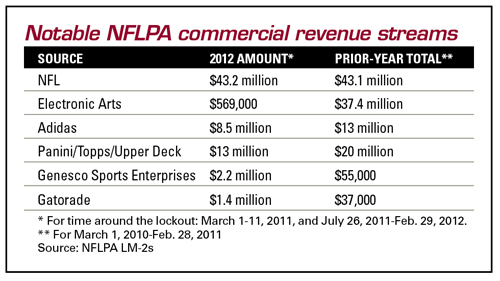The NFL Players Association reported $75 million in commercial revenue for the 7 1/2-month period around last year’s lockout, according to an analysis of the union’s recently filed annual report.
For the earlier, 12-month period that ended Feb. 28, 2011, licensing and sponsorship delivered $120 million to the union.
According to the NFLPA, licensing cash continued to flow during the March-July 2011 lockout, which the union said explained the discrepancy in figures in the annual filings to the Department of Labor. The union declined to provide more complete figures, and because it was not operating as a union during the 4 1/2-month lockout, it is not obligated to specify business for that time period in this year’s report, also known as an LM-2.
The NFLPA also declined to elaborate on the sharp decline in revenue reported in the most recent LM-2 from Electronic Arts, far and away the union’s biggest licensee. Between 2007 and 2011, EA paid an average of $32.3 million to the union, but the NFLPA reported in the most recent LM-2 a figure of $569,000, encompassing the period between July 26, 2011, and Feb. 29, 2012, as well as two weeks in March 2011 before the lockout.
“I am not obligated to and do not want to answer,” said union spokesman George Atallah in response to a question about the EA figure.
EA did not reply for comment.
In the past, the union has cautioned that the annual reports use cash accounting, reflecting only the cash that comes in during the period and not the value of contracts.
There was, however, a drop in the amount of money flowing to NFL players in the period covered by the most recent annual report, which was filed late last month. Disbursements, which represent payments largely to players, fell to $37.7 million in the reported 2012 period from $83.2 million.
 |
Drew Brees was the top earner of group licensing and marketing money.
Photo by: GETTY IMAGES
|
In the 12-month reporting period before the lockout, there were 72 players who received $100,000 or more in licensing and marketing money; in the more recent period, there were 29 players. In 2008, there were 114 such players.
New Orleans Saints quarterback Drew Brees earned the most of any player in the most recent period, taking in $962,678. This represents money he received from group licensing deals and appearances arranged through the union. It does not reflect licensing or sponsorship deals he did on his own. In the last full reporting cycle, New York Giants quarterback Eli Manning earned the most, with $2.4 million through the NFLPA.
It was unclear if the apparent drop in commercial revenue ties to the shift in how the group licensing and marketing of NFL players operates. Under the league’s prior collective-bargaining agreement, all deals had to flow through the NFLPA. Under the new deal agreed to last year, the NFL can go directly to player agents with group licensing deals.
“I know they still have the EA money coming in … so that deal is still a go. As far as the rest, without knowing for sure, in this new deal, they gave a lot of the marketing back to the NFL and are getting money in a different way; not sure how,” said one marketing source. “But that may be why it is showing different.”
NFLPA outside counsel Jeffrey Kessler, in a letter to players last month, underscored that the NFLPA remains in charge of its licensing and merchandise program. That program has been fundamental for the players since the mid-1990s, when the union took it in-house from the NFL.
One constant in the NFLPA’s revenue is money flowing from the NFL itself — ironic, given the union’s ongoing battles with the league. Through the commercial agreement between the union and league, which was struck simultaneously with the August 2011 CBA and means the NFLPA will not try to sign rival sponsors, the NFL paid the players $43 million in the most recent period, about on par with previous years. That means the NFL accounted for almost 60 percent of all NFLPA commercial revenue in the months after the lockout.
The LM-2 also shows sports marketing agency Genesco Sports Enterprises spending more with the NFLPA (see chart). Genesco represents NFL sponsors Verizon and Pepsi.
The LM-2 does not detail NFLPA Executive Director DeMaurice Smith’s new contract. He was given a new three-year term at the NFLPA annual meeting in March. New executive director contracts in the past have been detailed in the next LM-2, but no information is provided on this one. Atallah declined to comment. The LM-2 shows Smith earning $2.44 million in the measured period.





